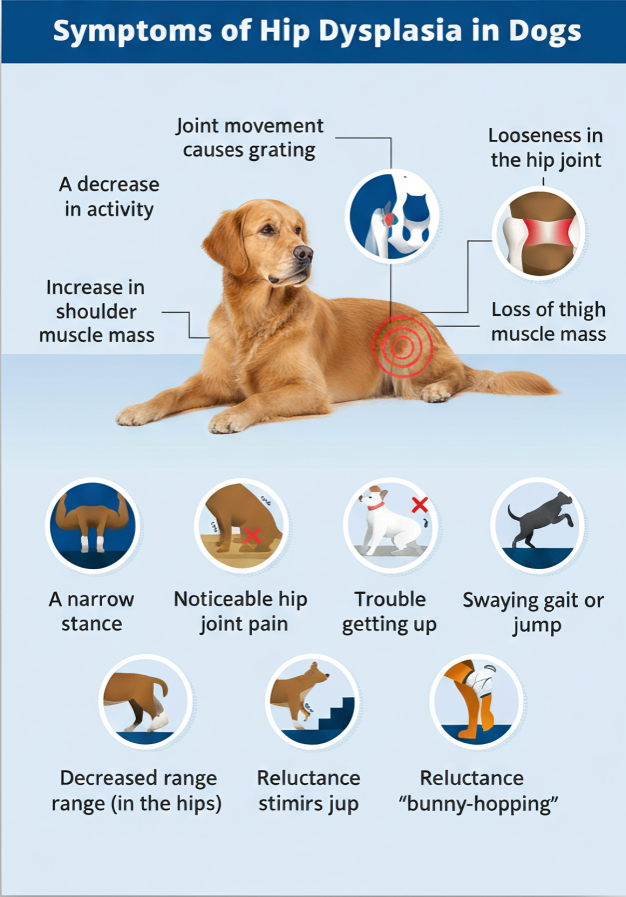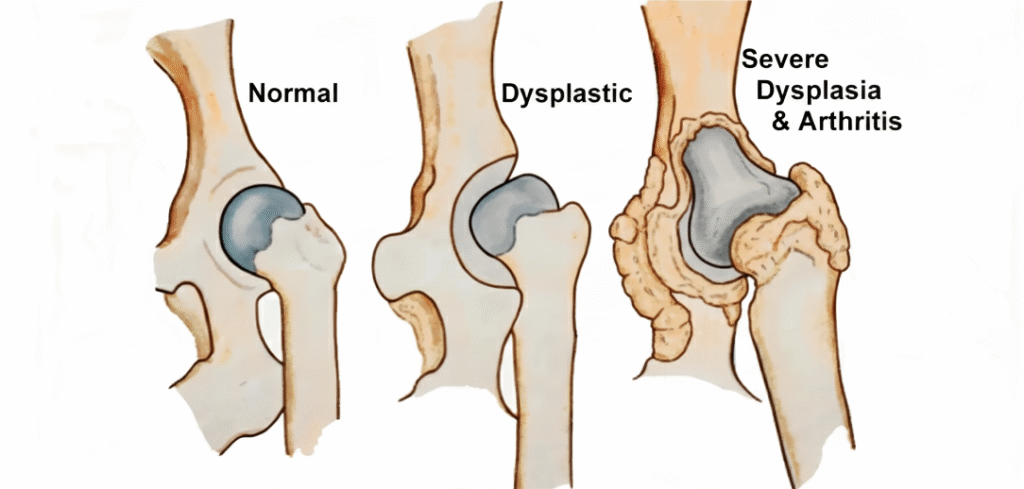Hip Dysplasia in Dogs: Your Complete Guide to Symptoms, Treatment, and Daily Care
Table of Contents
I. Introduction: Understanding a Common Concern
Hip Dysplasia in Dogs: Hearing this diagnosis can be frightening. It’s natural to worry about your furry friend’s comfort and mobility. Take a deep breath: this condition is common and manageable.
This guide cuts through the confusion. We’ll help you understand exactly what hip dysplasia dog means, explore all your treatment options, and provide actionable tips for improving your dog’s quality of life today.
II. What Exactly is Canine Hip Dysplasia (CHD)?
A. Simple Definition
Canine Hip Dysplasia (CHD) is an abnormal formation of the hip joint. Think of the hip as a simple “ball-and-socket” joint. When a dog has CHD, the ball and the socket don’t fit together properly. This mechanical failure is what defines Hip Dysplasia in Dogs.
B. Anatomy in Focus
The femoral head (the “ball”) should sit snugly inside the acetabulum (the “socket”). A poor fit causes joint looseness (laxity). This laxity leads to constant grinding and wear, resulting in painful joint damage, or osteoarthritis. Understanding this mechanism is key to treating Hip Dysplasia in Dogs effectively.
C. The Root Cause (Multifactorial)
CHD is rarely caused by just one thing. It’s often a combination of factors working together.
- Genetics (The Major Factor): Hip dysplasia in a dog is primarily hereditary. If a dog’s parents or grandparents had CHD, the risk for their offspring developing Hip Dysplasia in Dogs is significantly higher.
- Environmental Triggers: External factors like a diet leading to rapid growth, excessive weight, and improper, high-impact exercise during puppyhood can all trigger the condition in genetically predisposed dogs.
III. Who is at Risk? Identifying High-Risk Dogs
A. The Predisposed Breeds
While any dog can be affected, CHD is most prevalent in large and giant breeds. High-risk breeds include the German Shepherd, Labrador Retriever, Golden Retriever, Rottweiler, and Great Dane. If you are raising a German Shepherd puppy, managing their sensitive growth period is critical for preventing hip issues. For comprehensive guidance on their early development, consult our dedicated article German Shepherd Puppies
B. Age of Onset
The symptoms usually fall into two major categories depending on the dog’s age:
- Early Signs (Puppies, 4–12 months): This is the laxity phase. Puppies experience instability and joint pain as the joint moves too much.
- Late Signs (Adult/Senior Dogs): This is the arthritis phase. Symptoms stem from the secondary osteoarthritis that has developed over years of abnormal wear. Understanding these timelines helps manage hip dysplasia in a dog throughout its life.
IV. Spotting the Signs: Symptoms Owners Must Know
Early observation is key to managing hip dysplasia in a dog. Watch for these signs, especially in high-risk breeds.

A. Puppy Symptoms (Laxity Phase)
- “Bunny hopping” when running or climbing stairs.
- Reluctance to play or jump.
- An unusual, swaying, or wobbly gait in the hind end.
B. Adult Symptoms (Arthritis Phase)
- Difficulty or reluctance rising from a resting position.
- Limping (lameness) in the hind legs, often worse after rest.
- Loss of muscle mass in the thighs (atrophy).
- Noticeable stiffness or pain after exercise.
- Changes in sitting posture (sitting sideways).
C. The Stoic Dog
Remember that dogs are masters at hiding pain. Even subtle stiffness or hesitation warrants a vet visit. Subtle observation is essential when assessing signs of hip dysplasia in a dog.
V. Diagnosis: Your Visit to the Veterinarian
A. Physical Exam
Your veterinarian will perform a physical exam, including specific manipulations to check for joint looseness. The Ortolani sign is a common test involving pushing the hip joint to feel for a “clunk” that indicates excessive joint laxity.
B. The Gold Standard: Radiographs (X-rays)
X-rays provide the definitive diagnosis of hip dysplasia dog. Sedation is typically necessary to ensure proper positioning and muscle relaxation. The vet interprets the X-ray by looking for shallow sockets, femoral head flattening, and signs of existing arthritis.
C. Screening for Breeders (The Secondary Audience Focus)
For breeders and prospective owners, standardized screening is vital for prevention of Hip Dysplasia in Dogs.
- OFA (Orthopedic Foundation for Animals): This is a long-standing, commonly used method that grades hips (Excellent, Good, Fair, Borderline, Dysplastic) typically after the dog is 2 years old.
- PennHIP: This technique measures actual joint laxity using a specialized device, often providing a risk assessment much earlier than the OFA (as early as 16 weeks).
- Why is early screening important for breeding pairs? Early screening ensures that only dogs with genetically tight, healthy hips are used for reproduction, which is the best long-term strategy against CHD.
VI. Comprehensive Treatment Plan Options
The treatment approach for Hip Dysplasia in a Dog depends on the dog’s age, size, and the severity of its arthritis.
A. Conservative (Non-Surgical) Management
Conservative management is the first-line defense for most cases of Hip Dysplasia in Dogs, focusing on pain management and slowing arthritis progression.
- The Single Most Important Step: Weight Control: Maintaining a lean body weight is critical. Every extra pound significantly increases stress on the compromised hip joints.
- Pharmacological Management: This includes prescription NSAIDs (Non-Steroidal Anti-Inflammatory Drugs) to reduce inflammation and chronic pain. Other medications like Gabapentin may be added for controlling nerve pain.
- Joint Supplements: Supplements containing Glucosamine, Chondroitin, and Omega-3 Fatty Acids (Fish Oil) are often recommended to support cartilage health and reduce inflammation.
- Physical Rehabilitation: Low-impact therapy options like hydrotherapy (underwater treadmill) and controlled walks are wonderful for building muscle mass without straining the joint.
B. Surgical Interventions (When and Why)
Surgery is considered when conservative management fails or for young dogs who can be proactively corrected. Deciding on surgery for your hip dysplasia dog requires consultation with a veterinary specialist.
- Juvenile Pubic Symphysiodesis (JPS): This minimally invasive surgery is for young puppies (typically under 5 months) whose growth plates are still open. The goal is to alter pelvic growth to tighten the hips as the puppy matures.
- Triple/Double Pelvic Osteotomy (TPO/DPO): Reserved for young, skeletally immature dogs who have hip laxity but no severe arthritis. The surgery involves cutting and rotating the pelvis to better position the socket over the femoral head.
- Femoral Head Ostectomy (FHO): Often used for smaller to medium-sized dogs, this salvage procedure involves removing the femoral ball. The body creates a “false joint” supported by muscles, relieving bone-on-bone pain.
- Total Hip Replacement (THR): This is the most definitive, long-term solution. It involves replacing the natural joint with an artificial implant, resulting in excellent long-term function and pain relief.
- Follow-up Question: What is the typical cost range for each of these procedures? Surgical costs vary widely. Generally, THR is the most expensive (often $5,000–$8,000+ per hip), followed by TPO/DPO. FHO is typically the most budget-friendly surgical option.
VII. Daily Life with HD: Improving Quality of Life
You can make a huge difference in your dog’s comfort level at home when dealing with hip dysplasia dog.

A. Home Modifications
- Install non-slip flooring or traction mats, especially on hard surfaces, to prevent slips and painful spasms.
- Provide high-quality orthopedic bedding for joint support.
- Use ramps or short, stable dog stairs to eliminate jumping.
B. Safe Exercise Routine
The goal is muscle building without joint impact.
- Focus on controlled, low-impact activity, such as walking on a leash, or swimming, which is excellent for muscle building with zero joint stress.
- Avoid high-impact activities like intense games of fetch, jumping repeatedly, or long, sustained runs on hard pavement.
C. Monitoring Pain
Keep a simple checklist to track changes. Are they slow to rise? Are they licking their joints more? Does weather seem to affect them? Tracking these changes helps your vet adjust medication effectively.
VIII. Prevention: Giving Your Puppy the Best Chance
If you are raising a high-risk puppy, follow these guidelines to minimize their chances of developing severe hip dysplasia dog.
A. Controlled Growth Rate
Avoid over-feeding a large-breed puppy, which can lead to rapid weight and bone growth. The specific importance of feeding a large-breed puppy food for the correct duration is to control calcium and caloric intake during this critical growth phase.
B. Exercise Restriction
Avoid forced, excessive, or repetitive exercise while the puppy’s growth plates are still open. Short, frequent walks are better than one long run.
C. Responsible Breeding (For Prospective Owners)
Only purchase puppies from breeders who can provide official documentation (OFA or PennHIP scores) confirming that both parents have healthy hips. This is the single best preventative measure you can take.
IX. Conclusion and Next Steps
Hip Dysplasia in a Dog is a lifetime condition, but it is manageable. With the right combination of veterinary care, pain management, and home modifications, your dog can continue to live a happy, high-quality life.
Please don’t face this journey alone. Consult your veterinarian immediately for a personalized management plan. Check back here for future articles on supplements and in-home rehabilitation exercises